

|
|
Odd Man Out (Blu-ray)
Blu-ray B - United Kingdom - Network Review written by and copyright: Paul Lewis (26th June 2012). |
|
The Film
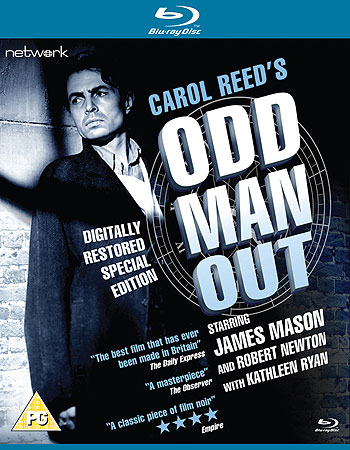 Odd Man Out (Carol Reed, 1947) 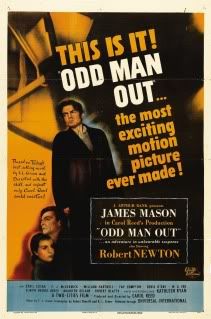 Immediately preceding director Carol Reed’s two adaptations of Graham Greene’s work, The Fallen Idol (1948) and The Third Man (1949), Odd Man Out (1947) is a film of equal quality to the latter, which is unarguably Reed’s most famous picture. However, Odd Man Out has its dedicated followers: in The Biographical Dictionary of Film, for example, David Thomson asserts that Odd Man Out is ‘one of the greatest Irish films ever made’ (2002: 722). Like The Third Man, Odd Man Out uses an experimental aesthetic, making use of canted angles and the kind of high contrast, deep focus photography that was in America rapidly becoming associated with films noirs such as John Huston’s The Maltese Falcon (1941) and, later, more visually baroque noirs like The Big Combo (Joseph H Lewis, 1955). Kristin Thompson and David Bordwell have argued that, as with American films noirs, the visual style of both The Third Man and Odd Man Out was in part shaped by an awareness of ‘emerging art-cinema norms’ such as Italian Neo-Realism (1994: 453). Immediately preceding director Carol Reed’s two adaptations of Graham Greene’s work, The Fallen Idol (1948) and The Third Man (1949), Odd Man Out (1947) is a film of equal quality to the latter, which is unarguably Reed’s most famous picture. However, Odd Man Out has its dedicated followers: in The Biographical Dictionary of Film, for example, David Thomson asserts that Odd Man Out is ‘one of the greatest Irish films ever made’ (2002: 722). Like The Third Man, Odd Man Out uses an experimental aesthetic, making use of canted angles and the kind of high contrast, deep focus photography that was in America rapidly becoming associated with films noirs such as John Huston’s The Maltese Falcon (1941) and, later, more visually baroque noirs like The Big Combo (Joseph H Lewis, 1955). Kristin Thompson and David Bordwell have argued that, as with American films noirs, the visual style of both The Third Man and Odd Man Out was in part shaped by an awareness of ‘emerging art-cinema norms’ such as Italian Neo-Realism (1994: 453).
The film is set in Belfast, where Irish nationalist Johnny McQueen (James Mason) – a fugitive on the run after escaping from prison where he was sentenced for smuggling guns and ammunition – arranges an armed robbery of a mill in order to raise funds for ‘the Organisation’. Whilst hiding out in the home of the elderly ‘Grannie’ (Kitty Kirwan) and her granddaughter Kathleen (Kathleen Ryan), Johnny and his associates, including Johnny’s friend and ally Dennis (Robert Beatty), plan the robbery. Although the men show confidence in their plan, they are less confident in Johnny’s abilities to lead them. Johnny is committed to the robbery and does not want it to descend into violence. Seeing that one of his colleagues is carrying a gun, he offers advice: ‘Go easy with those now’, he warns. When he is told that ‘Anyone that asks for it can have it’, Johnny firmly states, ‘Don’t encourage them to ask. We haven’t been mixed up in shootings before; we don’t want to start now’. Initially, the robbery goes to plan. However, on their way out the gang are confronted. Johnny is accosted by a guard and, during the tussle, he is shot in the shoulder. In retaliation, Johnny shoots and kills the guard. He manages to climb into the getaway car, but during the escape he falls from the vehicle. Badly injured, he finds his way to an abandoned air raid shelter, where he hides whilst the police hunt for him. There he waits, whilst at Grannie’s Dennis decides to go out into the city to look for Johnny. The remaining two members of Johnny’s group seek sanctuary in the house of Theresa (Maureen Delaney) but are betrayed when she secretly telephones the police; they are shot and killed outside Theresa’s house. 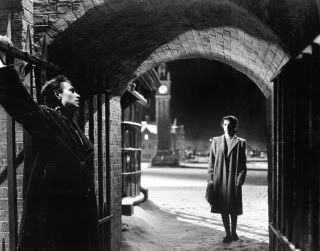 Dennis finds Johnny and makes a diversion for him, allowing Johnny to escape into the city. Eventually, Johnny finds his way into the home of Rosie (Fay Compton), who gives Johnny shelter. However, when her husband returns home and panics after recognising Johnny as the fugitive that the police have been searching for, Johnny is forced to go on the run once more. Meanwhile, Kathleen visits a priest, Father Tom (W G Fay). Tom introduces Kathleen to Shell (F J McCormick), who lives with two outcasts, Lukey (Robert Newton) and Tober (Elwyn Brook-Jones). Shell is looking for Johnny too, and finds him in a pub. Shell takes Johnny back to the dwelling he shares with Lukey and Tober, a failed medical student who attempts to dress Johnny’s wounds; a macabre artist, Lukey wants to paint the dying Johnny. Eventually, Johnny manages to escape the bizarre artist’s ‘studio’ and attempts to reach Father Tom and Kathleen. Dennis finds Johnny and makes a diversion for him, allowing Johnny to escape into the city. Eventually, Johnny finds his way into the home of Rosie (Fay Compton), who gives Johnny shelter. However, when her husband returns home and panics after recognising Johnny as the fugitive that the police have been searching for, Johnny is forced to go on the run once more. Meanwhile, Kathleen visits a priest, Father Tom (W G Fay). Tom introduces Kathleen to Shell (F J McCormick), who lives with two outcasts, Lukey (Robert Newton) and Tober (Elwyn Brook-Jones). Shell is looking for Johnny too, and finds him in a pub. Shell takes Johnny back to the dwelling he shares with Lukey and Tober, a failed medical student who attempts to dress Johnny’s wounds; a macabre artist, Lukey wants to paint the dying Johnny. Eventually, Johnny manages to escape the bizarre artist’s ‘studio’ and attempts to reach Father Tom and Kathleen.
Although Johnny is committed to the Irish republican cause, he is openly critical of the turn it has taken, presumably since his incarceration and during the six months he has spent hiding out in Grannie’s house. During the opening meeting with his associates in which they consolidate their plans for the robbery, Johnny criticises ‘the Organisation’s use of violence as a means of achieving its political aims. After the meeting, Dennis stays behind, observing, ‘Your heart’s not in this job, is it? [….] You don’t believe in everything’. To this, Johnny responds matter-of-factly, ‘I believe in everything we’re trying to do, but this violence isn’t getting us anywhere’, reflectively adding that ‘In prison you have time to think. If only we could throw our guns away, make our cause in the parliaments, instead of in the back streets’. Johnny’s denouncement of violence and his open dislike of guns makes the events leading up to his fugitive status (the accidental shooting of the guard at the mill) deeply ironic. Whilst on the run, Johnny finds sympathy – from Rosie and her daughter, and later from Fencie, a pub landlord (William Hartnell) – but very little direct help. ‘I’m not afore you, and I’m not against you, but I can’t afford to get mixed up in this’, Johnny is told by a man who he asks for help. Escape and sanctuary seem impossible. Early in the film, Johnny tells Kathleen that after the robbery, he plans to ‘head for the hills’ where ‘there are friends up there’, but almost confirming that this is little but a pipe dream, to Kathleen’s question ‘Johnny, will you ever be free?’, he responds by vaguely asserting ‘Some day, perhaps’. The lack of safety within the city is illustrated visually by the depiction of Belfast as a city of winding streets and dark alleyways, and is further illustrated in the sequence in which two of Johnny’s colleagues seek sanctuary in the house of Theresa. ‘People says queer things about her sometimes, but they says queer things about me too’, one of the men says, acknowledging that local gossip suggests Theresa may be an informer but choosing to ignore it all the same. Meanwhile, in the next room Theresa telephones the police; when she returns, she advises the men to ‘run for it’ and escorts them out of her house to the street outside, where they are cornered by the police and shot. Their deaths take place offscreen, the camera focusing on Theresa’s affectless reaction to the gunfire outside her house, her face pressed against her front door. After the noise has abated, Theresa ventures into the street. ‘I heard them running past my house, and then there was shooting’, she lies to one of her neighbours. 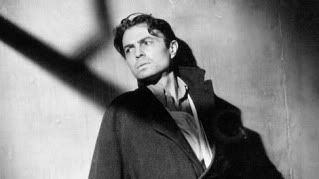 As noted above, the lack of sanctuary within the film’s narrative is partly communicated through a depiction of the city as a decentred, labyrinthine space, filled with dark alleyways and narrow, winding streets. In his monograph on The Third Man, Rob White argues that Reed ‘was one of the great directors of city-experience, and what he emphasised was disorientation and alarm. His heroes are purposeful in the city but hunted. There are traps all about and an ambush is always expected. Often it comes, if the purposefulness is forgotten or made impossible by injury, delirium, grief or obsession. In film after film, characters stumble along a street, their minds disintegrating. It happens throughout Odd Man Out’ (2003: 46). White suggests that Reed’s work features protagonists (such as Johnny or Harry Lime and Holly Martins in The Third Man) who are shown throughout the films to be in a ‘frantic hurry’; White argues that ‘[t]his frantic hurry is like a primal scene in Reed’s work. It is counterpointed by a photographic trope – the image of a head held back against a wall, of a body wanting to disappear into shadow, of eyes sensitive to any peripheral movement’ (ibid.: 47-8). White also discusses how Reed foregrounds the extent to which the city is a three-dimensional space where ‘the fugitive has an advantage. He can remain hidden, and he can move vertically as well as at ground level, on the look out for hiding-places and eyries above. Odd Man Out, The Third Man and The Man Between all insist on this advantage, showing their protagonists clambering up scaffolds, on window ledges, down winding stairs and mounds of debris – or, of course, moving and sheltering below ground, in the sewers [….] But always their advantage is lost and they die, gunned down. There is great pathos in the fatalism of Reed’s theme and the way it is worked out in the visual elaboration of space, height, distance and direction’ (48). In this sense, White argues, Reed’s films owe a debt to Julien Duvivier’s Pepe le Moko (1937) and its depiction of the Algerian casbah where Jean Gabin’s Pepe hides out, ‘a “tangled labyrinth”, a warren of cells, balconies, walkways and rooftops’ (ibid.). White that ultimately, the cities in Reed’s films ‘are also finally only prisons’ (49). As noted above, the lack of sanctuary within the film’s narrative is partly communicated through a depiction of the city as a decentred, labyrinthine space, filled with dark alleyways and narrow, winding streets. In his monograph on The Third Man, Rob White argues that Reed ‘was one of the great directors of city-experience, and what he emphasised was disorientation and alarm. His heroes are purposeful in the city but hunted. There are traps all about and an ambush is always expected. Often it comes, if the purposefulness is forgotten or made impossible by injury, delirium, grief or obsession. In film after film, characters stumble along a street, their minds disintegrating. It happens throughout Odd Man Out’ (2003: 46). White suggests that Reed’s work features protagonists (such as Johnny or Harry Lime and Holly Martins in The Third Man) who are shown throughout the films to be in a ‘frantic hurry’; White argues that ‘[t]his frantic hurry is like a primal scene in Reed’s work. It is counterpointed by a photographic trope – the image of a head held back against a wall, of a body wanting to disappear into shadow, of eyes sensitive to any peripheral movement’ (ibid.: 47-8). White also discusses how Reed foregrounds the extent to which the city is a three-dimensional space where ‘the fugitive has an advantage. He can remain hidden, and he can move vertically as well as at ground level, on the look out for hiding-places and eyries above. Odd Man Out, The Third Man and The Man Between all insist on this advantage, showing their protagonists clambering up scaffolds, on window ledges, down winding stairs and mounds of debris – or, of course, moving and sheltering below ground, in the sewers [….] But always their advantage is lost and they die, gunned down. There is great pathos in the fatalism of Reed’s theme and the way it is worked out in the visual elaboration of space, height, distance and direction’ (48). In this sense, White argues, Reed’s films owe a debt to Julien Duvivier’s Pepe le Moko (1937) and its depiction of the Algerian casbah where Jean Gabin’s Pepe hides out, ‘a “tangled labyrinth”, a warren of cells, balconies, walkways and rooftops’ (ibid.). White that ultimately, the cities in Reed’s films ‘are also finally only prisons’ (49).
During the manhunt Johnny becomes an idol for the local children, who are shown standing outside the police station and taunting the police by yelling, ‘I’m Johnny McQueen’. (Although it was not made until thirteen years later, it’s difficult not to watch this scene and think of the famous ‘I’m Spartacus’ sequence in Stanley Kubrick’s Spartacus (1960), where the captured slaves’ cry of ‘I’m Spartacus’ symbolises their desire to shelter Kirk Douglas’ fugitive leader of the revolt against the Roman Republic.) Later, whilst searching for Johnny, Dennis will encounter groups of children who, in play, pretend to be Johnny; to them, Johnny has become something of a folk hero. Rob White’s discussion of The Third Man foregrounds Reed’s use of children in his films. White notes that ‘Reed’s films of this period are unusual in being full of interesting children’ (op cit.: 38). White cites examples such as ‘the unspeakable Nina Almayer (Annabel Morley), shouting “pig!” at her father’s instigation in Outcast of the Islands (1951)’ and ‘Horse (Dieter Krause), the boy on the bicycle running errands for Ivo Kern (James Mason) in The Man Between (1953), doting on him […] and then causing his death because he cannot pass up on a last glimpse of his hero’ (ibid.). Focusing specifically on The Third Man, White suggests that ‘Greene and Reed shared the idea that innocence is almost always perilous. To cling on to innocence and idealism beyond childhood, assuming it is even possible, is, for both of them, to court disaster and to ignore the harsh reality of the world’ (ibid.: 39). For Reed, there is a dualism between innocence and adulthood. As a policeman who addresses Father Tom notes, ‘In my profession there is neither good nor bad. There is innocence or guilt, that is all’. The introduction of Father Tom suggests some possibility of redemption and escape. When Kathleen pays a visit to Tom, she believes that he may be able to help Johnny. However, he introduces Kathleen to another man, Shell. Speaking in metaphors and using the sick bird he carries with him in a cage as an example, Shell tells Kathleen that ‘there’s millions of men and women, but there’s rare ones among us, like this bird. Now this fella’s a chief, a devil of a fella, always making mischief – just like some fellas does [….] I must tell you, miss, Johnny is a menace to society. That’s why me and Lukey and Tober [who Shell lives with] have a rule saying that the door of his cage must be kept shut, because there’s other birds in my room besides Johnny, and he can’t stand them, and they can’t stand him. You know, there’s sort of a difference of opinion, like, between them’. Kathleen informs Father Tom that she wishes to take Johnny away, to rescue him; but Tom notes that ‘This time it’s different. He’s killed a man, and he must pay the penalty’. Kathleen says that she would rather kill Johnny herself: ‘The law would do it for revenge. I’d do it out of pity’. 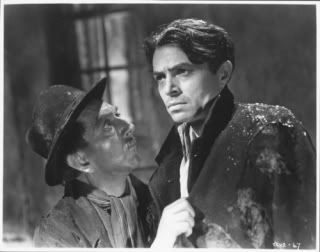 Eventually, Johnny falls into the hands of Shell, Lukey and Tober, captured in their squat. At this point, the film becomes highly symbolic and almost abstract, as the dying Johnny is tormented by the three members of Belfast’s underclass. In a macabre twist, Johnny is made to sit in a chair whilst the skidrow artist Lukey paints his portrait. ‘All the other people I’ve painted are living’, the disturbed Lukey asserts; ‘He’s near death. He sees it [….] There are wonderful thoughts in his eyes [….] I understand what I see in him [….] It’s the truth about us all’. Lukey’s obsession with painting the dying Johnny and recording his awareness of his own mortality almost carries Odd Man Out into the horror genre. The confusion of death and art is a set-up familiar from later horror films: Herschell Gordon Lewis’ Color Me Blood Red (1965), manga artist Hideshi Hino’s Mermaid in a Manhole (1988) and, more recently, Takashi Miike’s Detective Story (2007) all feature painters who, as if practising a form of alchemy through their art, attempt to capture and control death through using blood and other bodily fluids in their work; similarly, Pupi Avati’s The House With Laughing Windows (1976), a film which seems to draw on Edgar Allan Poe’s 1842 short story ‘The Oval Portrait’, focuses on a fresco depicting the death of Saint Sebastian, which local legend suggests was created by a Lukey-like artist who murdered young men and painted them as they expired. The sequence in which Johnny is forced to ‘sit’ for Lukey is unsettling and seems to offer an almost postmodern self-critique of cinema and its reliance on the spectacle of anguish, like Michael Powell’s Peeping Tom (1960). Eventually, Johnny falls into the hands of Shell, Lukey and Tober, captured in their squat. At this point, the film becomes highly symbolic and almost abstract, as the dying Johnny is tormented by the three members of Belfast’s underclass. In a macabre twist, Johnny is made to sit in a chair whilst the skidrow artist Lukey paints his portrait. ‘All the other people I’ve painted are living’, the disturbed Lukey asserts; ‘He’s near death. He sees it [….] There are wonderful thoughts in his eyes [….] I understand what I see in him [….] It’s the truth about us all’. Lukey’s obsession with painting the dying Johnny and recording his awareness of his own mortality almost carries Odd Man Out into the horror genre. The confusion of death and art is a set-up familiar from later horror films: Herschell Gordon Lewis’ Color Me Blood Red (1965), manga artist Hideshi Hino’s Mermaid in a Manhole (1988) and, more recently, Takashi Miike’s Detective Story (2007) all feature painters who, as if practising a form of alchemy through their art, attempt to capture and control death through using blood and other bodily fluids in their work; similarly, Pupi Avati’s The House With Laughing Windows (1976), a film which seems to draw on Edgar Allan Poe’s 1842 short story ‘The Oval Portrait’, focuses on a fresco depicting the death of Saint Sebastian, which local legend suggests was created by a Lukey-like artist who murdered young men and painted them as they expired. The sequence in which Johnny is forced to ‘sit’ for Lukey is unsettling and seems to offer an almost postmodern self-critique of cinema and its reliance on the spectacle of anguish, like Michael Powell’s Peeping Tom (1960).
The film’s movement into the realms of horror during its second half comes as something of a shock, as the early sequences in the film go to great lengths to paint a naturalistic portrait of Belfast. In The Biographical Dictionary of Film, David Thomson says that Odd Man Out ‘begins with a sense of the real Belfast—harsh, Dickensian […]—but as James Mason’s wounded hero grows weaker and more delirious, so fantasy and expressionism take over’ (2002: 722). Similarly, as Thompson and Bordwell (1994) suggest, there is a tension in the film between naturalistic footage of ‘Irish slums’ that was shot on location in Belfast, and ‘passages [that] stress a more subjective realism’ such as a sequence in which Johnny gazes at a pool of spilt beer and sees ‘various characters from earlier scenes of the film superimposed in the bubbles’ (453). Likewise, during the robbery Reed conveys Johnny’s anxiety expressionistically, through a series of shots taken from his point-of-view and filmed with what appears to be Vaseline smeared across the lens. In Belfast, Reed ‘took care to use both local people and some fine Irish actors’, with ‘[t]he unknown extras and the professionals together contribut[ing] significantly to the film’s sense of place’ (White, 2003: 28). Along with the experimental photography and editing, Reed’s technique of employing both professional and non-professional actors also allies the film with roughly contemporaneous European art cinema movements: both Robert Bresson and Pier Paolo Pasolini famously used non-professional actors in their films. 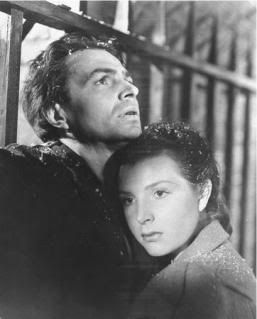 Like Pasolini’s films, Odd Man Out offers a subtle critique of faith and foregrounds the theme of redemption. Ultimately, the only promise of redemption seems to come from Kathleen’s love for Johnny. Discussing Johnny’s fate with Father Tom, Kathleen tells the priest that ‘I only know that what I feel is stronger than my religion, stronger than myself’. ‘Kathleen, where’s your faith’, Tom asks. ‘My faith is in my love [….] I believe that what I intend to do is good’, she responds. However, Grannie advises Kathleen to forget Johnny. As the police search Grannie’s house, she warns Kathleen, ‘Where’s the sense you running out to all this trouble when you know you can’t mend it’ and suggests she turns her back on McQueen. Grannie tells Kathleen that she was once engaged to a ‘rebel on the run’ but turned her back on him, eventually marrying another man and living a happy life because of it. Despite Grannie’s warnings, Kathleen has her doubts and continues to search for Johnny. Like Pasolini’s films, Odd Man Out offers a subtle critique of faith and foregrounds the theme of redemption. Ultimately, the only promise of redemption seems to come from Kathleen’s love for Johnny. Discussing Johnny’s fate with Father Tom, Kathleen tells the priest that ‘I only know that what I feel is stronger than my religion, stronger than myself’. ‘Kathleen, where’s your faith’, Tom asks. ‘My faith is in my love [….] I believe that what I intend to do is good’, she responds. However, Grannie advises Kathleen to forget Johnny. As the police search Grannie’s house, she warns Kathleen, ‘Where’s the sense you running out to all this trouble when you know you can’t mend it’ and suggests she turns her back on McQueen. Grannie tells Kathleen that she was once engaged to a ‘rebel on the run’ but turned her back on him, eventually marrying another man and living a happy life because of it. Despite Grannie’s warnings, Kathleen has her doubts and continues to search for Johnny.
The redemption offered by the Catholic church, as represented through Father Tom, is criticised by Reed. White argues that the scene at the end of Odd Man Out in which Johnny collapses in the snow-covered garden of a terraced house, a beam of light cascading on his face, suggests that ‘given his halting progress on a “white road” through the city towards “crucifixion”, it seems as if this shot may be part of a Christian allegory’ – that is, until the source of light is revealed to be a ‘window out of which two boys look in delight at the descending snow […] with no clear sight of the falling man and even less concern’ (55). As White argues, ‘[t]here is no light from heaven and no “dreadful martyrdom” here, just an accidental light and the slow dying of a wounded man for whom few tears will be shed’ (ibid.). White suggests that in Odd Man Out, as in elsewhere in Reed’s work, ‘Christian symbolism is [therefore] summoned up […] and then rejected’ and, comparing the film with T S Eliot’s The Wasteland, White contends that there is a ‘sense of a world in which religion and ancient rites are a distant backdrop to modernised, mechanised and faithless urban life, with its cultural fragmentation and in all its profanity and banality’ (55).
Video
Encoded with the AVC MPEG-4 codec, this Blu-ray release seems to be based on the same restored transfer that Network used for their 2006 DVD release, which was a major improvement over the earlier DVD release from Carlton, which suffered from some pretty nasty cropping, and the US release available from Image Entertainment. Presented in 1080p, this transfer exhibits strong contrast and a natural level of grain and detail. The expressionistic lighting is carried nicely by the encode, and there is a real sense of depth to the noir-ish visual style of the film. There is some wear and tear on the print (vertical scratches, mostly), but it looks natural and film-like. It’s not as polished as the restored transfer for Casablanca (Michael Curtiz, 1941), say, but it’s comparable to Warner’s Blu-ray release of The Maltese Falcon (John Huston, 1941). All in all, this is a very pleasing presentation of the film that, playing to the strengths of the format, improves over the already impressive 2006 DVD release from Network in terms of detail and clarity. Odd Man Out is presented here uncut and runs for 115:54 mins. The film is presented in its original aspect ratio of 1.37:1.
Audio
Audio is provided via a rich and clear two-channel LPCM track. The film also features optional English subtitles.
Extras
This Blu-ray shares its extras with Network’s 2006 DVD release. The disc contains a 1972 interview with James Mason entitled ‘Home James: James Mason Turns Again to Huddersfield’, produced for Yorkshire Television (51:39). In this, Mason returns to his home town of Huddersfield. It’s an illuminating piece, warmly narrated by Mason, who discusses the history of Huddersfield and his relationship with the town. Also included as a separate 'extra' is an additional 12:41 mins of unedited interview footage with Mason. Four image galleries are included: ‘Behind the Scenes’, ‘Portraits’, ‘Production’ and ‘Publicity’. The titles of these are self-explanatory. A booklet is apparently included with retail copies of this disc; this was not available for this review.
Overall
 Odd Man Out is a truly great film; it’s arguably a better film than The Third Man, which is Reed’s most famous picture. Mason gives a great central performance as Johnny McQueen, and the film is both thematically complex and visually interesting, displaying some of the visual tropes associated with the then-burgeoning film noir trend in American cinema. Odd Man Out is a truly great film; it’s arguably a better film than The Third Man, which is Reed’s most famous picture. Mason gives a great central performance as Johnny McQueen, and the film is both thematically complex and visually interesting, displaying some of the visual tropes associated with the then-burgeoning film noir trend in American cinema.
David Thomson says that in the ‘run of films’ James Mason appeared in after the Second World War, ‘he brought a unique sensuality to polite arrogance’ (2002: 572). Here, he is shorn of his unique accent, which Thomson describes as ‘a blend of Yorkshire and trans-Atlantic drawl’; in this film, Mason’s distinctive accent is replaced by an almost faultless Irish accent – which is admittedly more Dublin than Belfast, as are many of the accents in the film (ibid.). This is probably due to many of the actors being recruited from Dublin’s Abbey Theatre, and perhaps due to the relative ‘softness’ of the Dublin accent as compared with the harder tones of Northern Irish speech. Speaking of accents, Tober’s use of received pronunciation is a nice touch, suggestive of the character’s past as a medical student and the presumed fall from grace that has led to him keeping company with Lukey and Shell. This is an excellent release of Odd Man Out. The restoration is solid, and seems to be represented well on this Blu-ray. It’s maybe not up to the standards of Warner’s restoration of Casablanca, for example, but it’s certainly comparable to Warner’s release of The Maltese Falcon. The hour long documentary about James Mason’s relationship with his home town of Huddersfield is interesting: it may not have immediate relevance for the film, but it’s a fascinating documentary nonetheless. In sum, this Blu-ray release comes with the strongest recommendation and, for the HD transfer, represents a solid upgrade over the previously available DVDs. References: Spicer, Andrew, 2003: Typical Men: The Representation of Masculinity in Popular British Cinema. London: I B Tauris Thompson, Kristin & Bordwell, David, 1994: Film History: An Introduction. London: McGraw-Hill Thomson, David, 2002: The Biographical Dictionary of Film. London: Little, Brown (Fourth Edition) White, Rob, 2003: BFI Film Classics: ‘The Third Man’. London: British Film Institute For more information, please visit the homepage of Network Releasing. This review has been kindly sponsored by: 
|
|||||

|